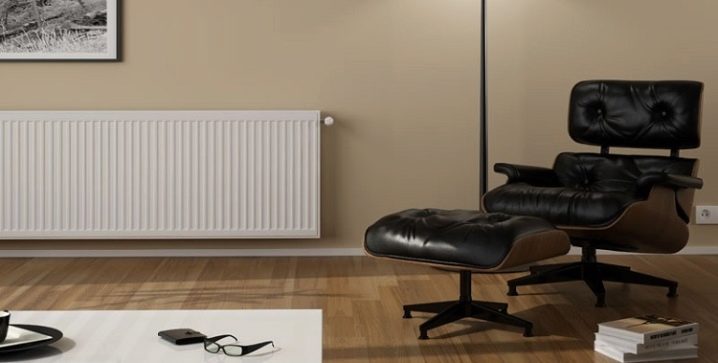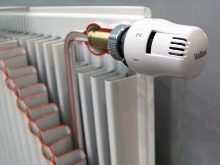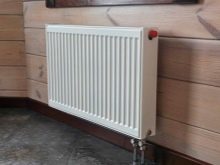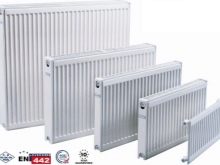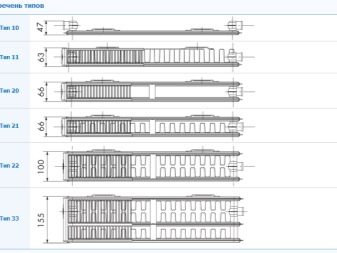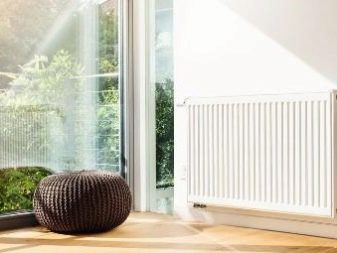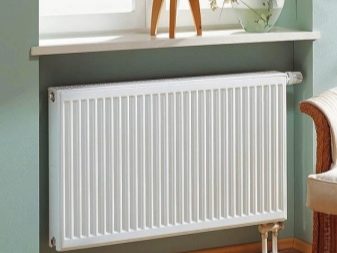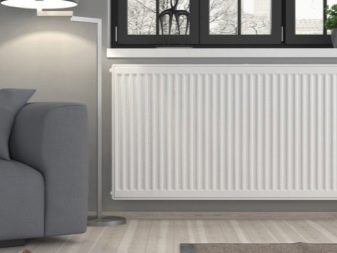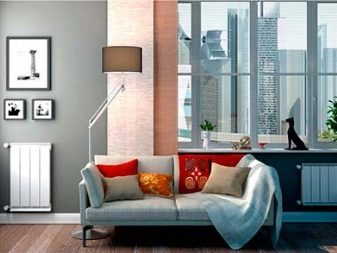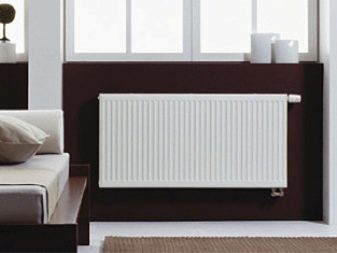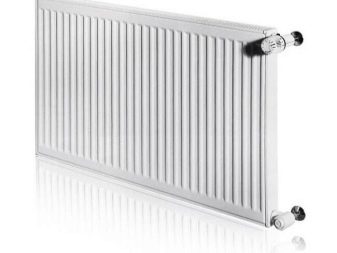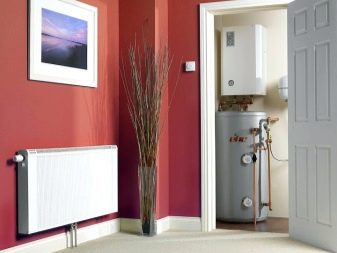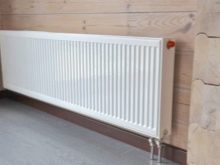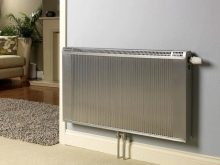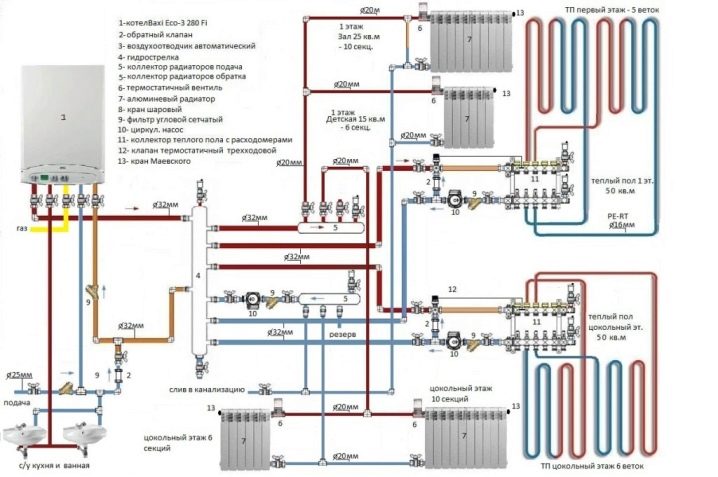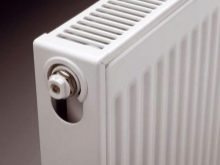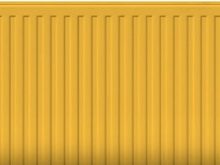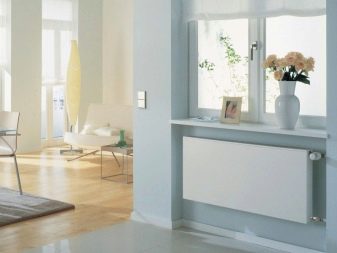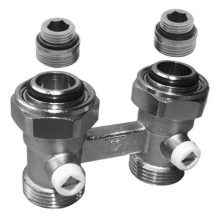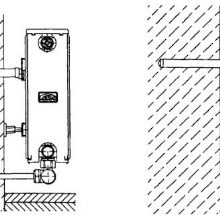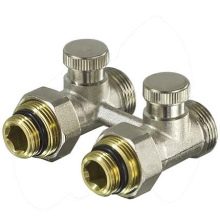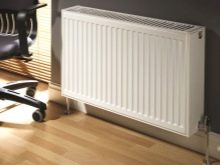Panel radiators: pros and cons, types of designs and connection options
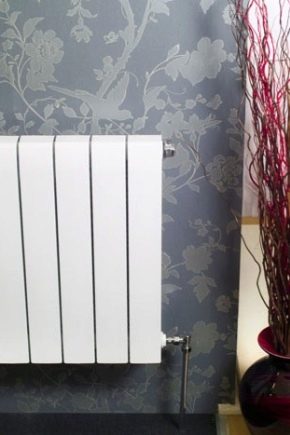
Panel radiators are in great demand when installing autonomous heating in residential buildings, offices and shopping centers. Such a great popularity is due to the high technical properties of devices, as well as their modern design, which is represented by a huge selection of styles and sizes.
In addition, modern electrical appliances are easy to install and are ideal for individual and central heating systems.
Features and device
Panel radiators are modern heating devices consisting of steel panels and designed for various heating systems in private houses and apartments. To improve convective heat transfer and to increase the area of heat transfer inside the panels, special steel fins having a U-shape are placed.
Due to this, the heat transfer rate increases to 50%. The main feature of such products is the absence of sections, instead of which the front side is decorated in the form of a solid panel created from two sheets of steel with a thickness of 1.25 mm.
Sometimes there are also models of galvanized steel, in which the fins of the plates is made of metal with a thickness of 0.04 to 0.5 mm. Outside, panel-type devices are primed and painted using the powder method. Standardly radiators are painted white, but you can also find colored panels made by manufacturers under the order.
Usually products consist of two or three panels, decorated on the side and on top of the grille. As a result, the radiator takes on an aesthetic appearance and fits in with any modern design in an original way.
Due to the fact that the volume of the panels is small, instantaneous heating is observed in the OS, since heat exchange occurs very quickly.
Therefore, already 15 minutes after switching on the device, the room will be warm, because heating is performed not only by transferring warm air, but also by releasing heat from the housing itself.
Panel radiators are great for use in country housesThis is due to the fact that they are designed for workflow with low pressure system. As for apartments in multi-storey buildings, these devices, as a rule, are installed in the presence of autonomous systems, since the pressure in centralized systems often exceeds 10 atmospheres. Also, the panel option is not recommended for centralized heating, because coolant contamination and its failure can occur.
Advantages and disadvantages
Today, panel batteries can be found on the market of various countries, as they are the most traditional device that provides high-quality heating and meet the requirements for energy saving.
The main advantages of such radiators include:
- Stylish design.The product looks simple and neat in appearance. Manufacturers produce appliances in various designs, ranging from classic to modern.
- Convenient adjustment. The degree of heating can be easily controlled using mechanical and electronic devices.
- High heat dissipation. Due to the special principle of convection, the device has an increased efficiency.
- Affordable price. Compared with other types of heating devices, panel radiators are cheaper because they are made from steel.
- Energy savings. The device has a small capacity, so much less electricity is consumed for heating it.
- Multifunctional. The product can be used both as a radiator and a convector.
- Low weight. The design is light, so its installation is quite realistic to do it yourself.
- Large selection of model range. On the market are radiators of any size and power.
As for the shortcomings, the panel batteries are not too ideal for the following indicators:
- Instability to water hammer. Because of this, radiators cannot be connected to central heating systems.
- High sensitivity to acidic environment. To protect the steel surface of the product from corrosion, it is necessary to constantly maintain its pH level in the range from 8.3 to 9.5.
- According to the instruction manual, it is forbidden to drain water from the system for a long time. If this is not done, the inner walls of the panels will come into contact with oxygen, which will entail their corrosion.
Characteristics and sizes
On sale are found panel radiators of various types, they differ among themselves not only in design, but also have certain dimensions and power.
Depending on the connection method, the coolant is divided into two types:
- With bottom connection. In these models, the battery nozzles are located below. Their installation, as a rule, is convenient if the pipes of the heating system pass directly into the floor. But in this case, it is necessary to consider that the heat loss will be great.
- With side connection option. In radiators, the outlet pipe is arranged on the bottom and the inlet - on the top. Due to this design, the device provides the room with uniform heating. The exceptions are products consisting of many sections, they are characterized by significant heat loss.
These batteries can be manufactured with a different number of panels, so they are classified into the following types:
- Type 10. They have the form of a single-row device without a complete set of convector channels.
- Type 11. Consist of only one panel, but, unlike the previous type, equipped with a steel crate, responsible for air convection.
- Type 21. The device is represented by two panels that provide good heating to large areas.
- Type 22. The design of the device has two panels and a batten. The air ducts in this case are arranged on both sides of the battery.
- Type 23. It is the largest panel product in which the design consists of three panels having three rows of fins.
As for dimensions, radiators are usually available in widths from 40 to 300 cm and heights from 30 to 90 cm. Therefore, before buying a heating device, it is necessary to correctly calculate the power of the system, the area of the room and, starting from this, choose the appropriate size of the radiator.
Varieties and selection criteria
Panel-type radiators are equipped with both convective and hygienic fins, which implies the absence of convective plates.Hygienic batteries are distinguished by the fact that they can be easily cleaned from dust. They are made without decorative gratings, so this design is characterized by easy access to the internal structure of the product. Such models are installed mainly in hospitals and other types of premises with high hygienic requirements.
Depending on the type of front panel, the devices are available with a grooved, smooth and flat surface. Products with a flat surface may have vertical or horizontal grooves. Thus, the external case of the device is assembled from standard and decorative panels.
Metal radiators are best connected to the autonomous heating system. If they are embedded in a centralized system, the service life of the devices will be halved.
In order for the device to reliably last a long time, experts recommend choosing the following nuances when choosing it:
- Performance indicators. The pressure in the heating system should not reach 10 bar. Some manufacturers produce products that can maintain a pressing pressure of 13 bar, but the water temperature in this case is no more than + 110 ° C.
- Thermal power. For each type of radiator it is installed individually.
- Connection method. Typically, devices are mounted either from below or from the side, so the choice is determined by both personal preferences of users and the features of the heating system.
- Availability of additional features. Most modern models are equipped with a thermostatic valve, which allows you to effectively maintain a certain temperature in the room. In addition, the design can be supplemented with temperature controllers that simplify the control of heating.
Accessories and manufacturers
Panel radiators are connected to the heating system with special accessories. Therefore, before starting the installation, it is important to check the availability of such important parts as radiator valves and brackets. In case installation of the device with the bottom connection is carried out, knots with a cap nut are used. To install floor radiators using a special bracket, it is worth noting that the quality of the battery depends not only on the type of devices, but also on the manufacturer.
Among the many brands, the following brands have worked well:
- Lidea (Russia). This manufacturer has received many positive reviews, since all its products are of high quality finish. Radiator panels are covered with a unique two-layer lacquer, and the devices can work in a single-pipe and two-pipe heating system.
- Biasi S. p. A. (Italy). The radiators of this company are created using the latest technologies, so their heat transfer is high, and the space is heated instantly. The devices can also operate at low temperatures, the limit of their working pressure is 9 bar.
- Korado (Czech Republic). Batteries have both one and two or three panels. The main feature of the products is their wide color range, small volume of coolant, comfortable brackets. The pressure limit reaches 8.7 bar, and the water is heated to +110 C.
- Radson (Belgium). The foreign manufacturer presented unique batteries, in which on each channel of the panels there are two edges of convectors. Thanks to this design, the amount of heat carrier is reduced. Separate attention is also worthy of compact models of radiators designed to heat small rooms.
The advantage of the products is that they are painted using special technology KTL2.The thickness of their coating is at least 50 microns, and the limit of the working pressure is 10 bar.
Equipment and installation methods
Panel batteries with lateral connection do not need to be completed, they already have an internal thread into which a pipe or a tap can be installed. But despite this, I usually sell them with plugs and a Mayevsky crane.
The radiators with the bottom connection in their design have two nozzles and a sockettherefore for their installation the additional complete set is not necessary. As for the standard devices with a basic installation, during their purchase it is important to check that the box has floor fasteners, a manual air vent and a plug. Regardless of the type of radiator, during its connection you can not do without ball valves and special control valves. Thanks to these details, the flow is adjusted.
When installing batteries with a bottom connection, also use multiflexes or separate shut-off nodes.
Multiflexes are both angular and straight. They are directly joined to a radiator and piping made from various materials.Thanks to these accessories, the device can be removed while leaving the station in working condition. As for the methods of installation, they are determined individually, taking into account the material of the pipes. Ball valves are well suited for polypropylene pipes, and fasteners are made by welding. If the pipeline is metal-plastic, then it must be taken into account that there may be press or fitting pipes in it.
The first type is simply twisted with nuts, and the second is squeezed with special tongs. In addition, the radiator can also be connected with the help of valves with euro cone. Usually the installation process does not take much time. First, the valve is disassembled, then the union with the cap nut is screwed into the battery and docked. To do the job qualitatively, you need to have on hand a special key for an American. At the end of the installation all threaded connections must be sealed with a gasket.
Useful tips and reviews
Panel-type radiators are easy to connect, so it’s quite realistic to install them yourself. In order to increase the operational life of the heater, it is necessary not only to choose the right model for the room, but also to adhere to all the rules for its technical use.
Therefore, before installing, consider the following points:
- For private houses and apartments, it is best to purchase steel radiators with a working pressure of at least 8 bar. They have positive user reviews, as they significantly reduce energy costs and are characterized by a reliable system.
- During the installation of the device, the thermostatic panel can be removed and a simple side connection can be made.
- Panel batteries of the same type and size have a similar power value, which can differ only by 10%. Therefore, this allows you to save money on design, as the devices have similar design and parameters.
- Connecting the radiator to the heating system, you need to create optimal conditions for air circulation. For this, a distance of 100 mm is left between the window sill and the device.
- It is advisable to purchase panel batteries, taking into account not only the width of the windows, but also the expected heat loss during heating. If this is not done, the microclimate in the room may deteriorate, or the cost of electricity will increase.
- Going to buy, you need to carefully examine consumer reviews about a particular brand.In addition, the choice will depend on the conditions in which it is planned to operate the radiator.
Some models of devices are intended only for clean rooms, and they should not be installed in places where there is a lot of dust.
In the next video you will find a review of steel panel radiators.
